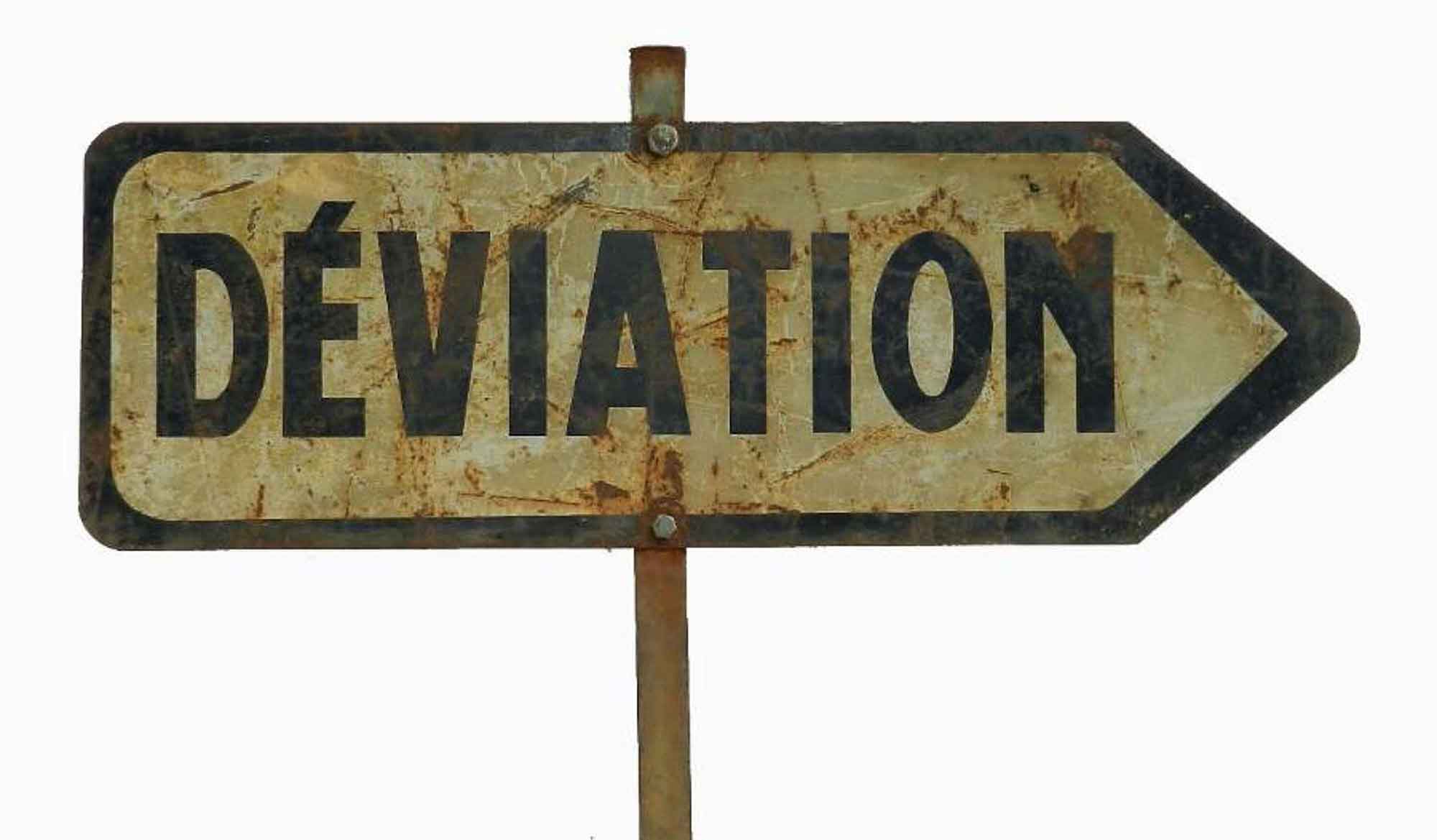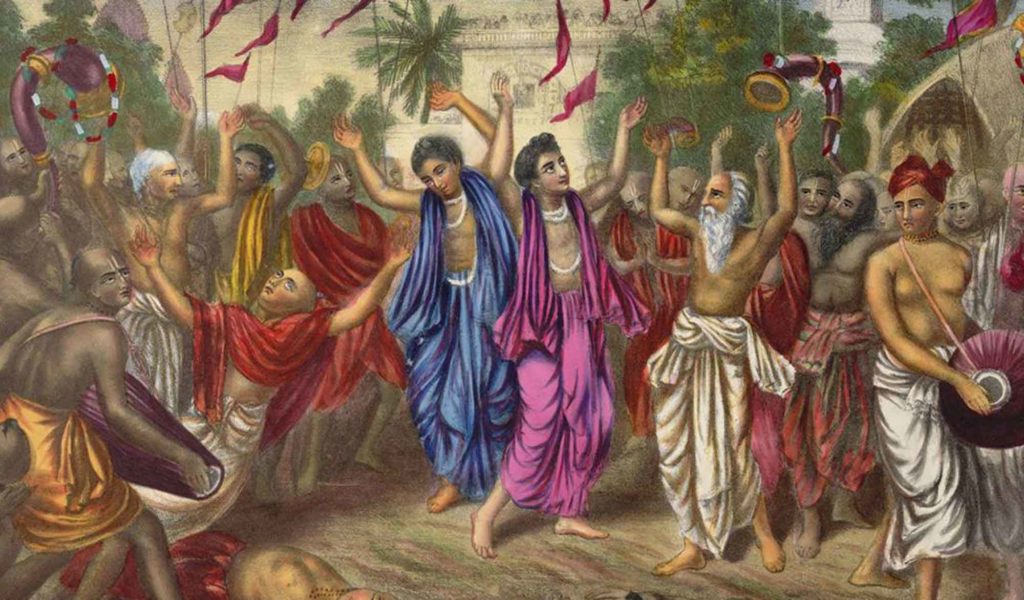Overview
Swami B.V. Giri replies to a question concerning the bhāgavat-paramparā as presented by an ācārya in a recent publication, and asks whether the author is trying to ingratiate himself with the sahajiyās and caste-gosvāmīs.
(The following is taken from a recent email exchange between a devotee and Swami B.V. Giri)
G.M. Dāsa: Daṇḍavats Mahārāja, recently I read a new book by one prominent Gauḍīya Vaiṣṇava guru and some of the content confused me. In one of the chapters, he links our paramparā directly with the Advaita-vaṁśa through Kṛṣṇa Miśra, the son of Śrī Advaita Ācārya. What do you think about this?
Giri Mahārāja: Daṇḍavats prabhu, I have also seen this book. Many of the points the Author makes in the book are correct, but some of the answers found in the book can only be compared to finding a lump of rock-salt in one’s sweet rice. They are not in line with our pūrvācāryas (previous ācāryas) and are extremely misleading. The instance you have cited is one such example.
Śrīla Bhaktisiddhānta Sarasvatī Prabhupāda stressed the bhāgavat-paramparā, over the dīkṣā-paramparā, because we aspire to be sāragrāhī Vaiṣṇavas – devotees who consider substance over form. However, in his book, the Author has done the opposite. He has linked our paramparā with the Advaita-vaṁśa. Why he has done that, I do not know. Perhaps he feels that our pūrvācāryas have given too much stress to the bhāgavat-paramparā and now it is time to give importance to the dīkṣā line, or perhaps he is bending under pressure from so-called ‘traditional’ Gauḍīyas who claim we have no lineage. Whatever the case, by stressing form over substance, he automatically eliminates so many important ācāryas in our line – in particular Śrīla Bhaktivinoda Ṭhākura.
Śrīla Śrīdhara-deva Gosvāmī Mahārāja has stated that, “We are inclined to think of ourselves as ‘bhaktivinoda-parivāra’ (members of the spiritual family of Śrīla Bhaktivinoda),” and Śrīla Sarasvatī Ṭhākura considered Bhaktivinoda Ṭhākura to be his substantial guru. How can anyone professing to be a follower of Śrīla Sarasvatī Ṭhākura (especially someone who is a guru or ācārya), eliminate Bhaktivinoda Ṭhākura from our paramparā?
None of the previous ācāryas in our line have ever stressed that we are substantially connected to the Advaita-vaṁśa. In the book, Guru – The Universal Teacher, Śrīla Bhakti Pramoda Purī Gosvāmī has discussed this point and quoted his illustrious Gurudeva, Śrīla Bhaktisiddhānta Sarasvatī Prabhupāda:
“In the Gauḍīya Vaiṣṇava sampradāya, dynastic guru lines generally establish their legitimacy by claiming to be descended from associates of Sri Caitanya Mahāprabhu such as Nityanānda Prabhu or Advaita Prabhu. Because Nityānanda and Advaita are accepted by all Gauḍīya Vaiṣṇavas as viṣṇu-tattva, and because the guru is to be treated as equal to God Himself, the members of these families consider themselves possessed of some divine prerogative. This is dangerous and can lead to abuses. Śrīla Prabhupāda pointed all these things out fearlessly. In his Vivṛti on Śrīmad Bhāgavatam 11.6.26, he wrote about the destruction of the Yadu dynasty at the end of Kṛṣṇa’s līlā:
“No such destructive curse appears in gaura-līlā, which is centered on the principle of separation. Even so, just as Kṛṣṇa left no direct descendants, so there is no indication that any kind of bloodline of descendants came through Caitanya Mahāprabhu or any of His associates. Nityānanda Prabhu, the incarnation of Balarāma, had only one son, Vīrabhadra Prabhu, who had no children but spread his teachings through initiated disciples in accordance with the varṇāśama system. Similarly, with the one exception of Acyutānanda, Advaita Ācārya Prabhu did not make any of His own children particularly qualified in the matter of devotional service. Moreover, although there was no external apocalypse in the bloodlines of Lord Caitanya and His companions as there was in the case of kṛṣṇa-līlā, many of the descendants of these associates of the Lord were cursed to become so involved with mundane society that they were deprived of the supreme goal of prema, which Mahāprabhu came to give.” (Guru – The Universal Teacher, Chapter 3)
The apa-sampradāyika anti-parties criticise Sarasvatī Ṭhākura’s emphasis on substance over form, claiming that there is no such thing as the bhāgavat-paramparā. However, when we look at the works of Śrī Kavi-karṇapura and Śrīla Baladeva Vidyābhūṣaṇa, we find paramparā listings that do not stress the formal dīkṣā connection, but rather emphasise the substantial connection. In regards to the bhāgavat-paramparā, Śrīla Śrīdhara Mahārāja has said:
“This was taught to us, against vehement opposition from the kūla-gurus and these bābājī’s also. “The Gauḍīya Maṭha does not recognise guru-paramparā in reality” – that is their general complaint. The bābājī class, and the kūla-guru class, gosvāmī class are very loud in their assertion that, “Gauḍīya Maṭha has got no importance in the recognition of the guru-paramparā, which is so important for a Vaiṣṇava, for a devotee. They do not care for that.” That is the general complaint against Gauḍīya Maṭha. But we are not bound by any flesh connection. We only want the gist of the paramparā. Wherever that is to be found, I shall bow down my head. And whatever respectable body-connection one may have, I have nothing to do with that. No body connection.”
Devotee: “Sometimes these people demand that we produce some evidence to prove our paramparā is genuine.”
Śrīla Śrīdhara Mahārāja: “It is not undetectable. One who has the eye to see, then he cannot but follow this idea. We also have guru-paramparā. In the days of Mahāprabhu, they also had guru-paramparā. But they left everything and came to the parṣadas of Mahāprabhu – Advaita, Nityānanda Prabhu, Gadādhara. Why did they come? They had their guru-paramparā already! Guru-paramparā does not mean the succession of the body. Succession of the thought of Kṛṣṇa Consciousness – we have to chase that, because we are beggars for that. Not for anything else. Not for formality, not for the material thing, knowledge, jñāna, whatever. But for the substance, not for the form. That attitude is shown in our guru-paramparā, so we are to follow that.
In history also we find…in England the main powerful kings are traced and the others are in the background. Unqualified kings are left in the background. In the order of the president or the king – everywhere. Non-important – background. Individually anyone can come and learn from Napoleon, from Alexander, from Hannibal – their strategy, tactics and their bravery. Not the gap between Hannibal, Alexander, Napoleon, Julius Caesar…the specialist has to learn from that, not from an ordinary general in that period. They won’t care.
All individuals will be left out in-between. In this way, the stalwarts who have got some substantial contribution, we are indebted to them. We want to keep up their gift for the benefit of all, and for ourselves also. We want the substance, and not the form, to a certain extent. As much as possible, maintainable, we can show our regard for that form. But mainly the substance. The contained, and not the container…but the container to certain extent. And what is contained there, that will have the most important attention. In guru-paramparā we have accepted that. There it is clear. When you have accepted that guru-paramparā, then it is clear.”
It seems to me that the Author has played into the hands of the enemies of Śrīla Bhaktivinoda and Sarasvatī Ṭhākura and is trying to appease them by paying more attention to the formal connection. Otherwise, why does he not give any attention whatsoever in his book to the bhāgavat-paramparā that his own Gurudeva and Parama-Gurudeva stressed? He has given a long list of unfamiliar names connected to Advaita Ācārya’s son, Śrī Kṛṣṇa Miśra, down to Sarasvatī Ṭhākura, but has neglected to give a list of ācāryas in the bhāgavat-paramparā. Furthermore, he has not given any explanation as to the difference between the substantial paramparā and the formal paramparā, nor any reason why the followers of Sarasvatī Ṭhākura emphasise the substantial paramparā.
In a conversation with disciples in 1998, Śrīla Purī Mahārāja spoke about the bhāgavat-paramparā as follows:
“Śrīla Prabhupāda called our disciplic succession the bhāgavat-paramparā. Why did he give it this name? Normally, people give a list of gosvāmīs’ names – all those who belonged to that particular family of gurus. Sometimes these include women. Was every one of these people a perfected soul or siddha? What do we mean by siddha? There are sādhakas or aspirants for perfection and siddhas, or those who have attained perfection. The name is there, siddha-pranāli, but it is not enough just to have a name. Have they all attained perfection on the path of devotion? Devotion begins with practices that we call sādhana. But when one becomes perfected in these practices, he is called siddha.” (Jagannātha Purī, September 28th 1998)
In other words, the bhāgavat-paramparā, as taught by Śrīla Bhaktisiddhānta Sarasvatī Prabhupāda, is a list of prominent siddha devotees. What the Author has presented in his book is simply a list of names in the ‘flesh paramparā.’ In the above quote, Śrīla Purī Gosvāmī asks, “Was every one of these people a perfected soul or siddha?” Good question! Perhaps the Author can tell us.
Apparently, the Author’s book is meant as a primer for new devotees to establish essential Vaiṣṇava teachings – but this begs the question, “What is the necessity of introducing new devotees to a paramparā, devoid of Bhaktivinoda Ṭhākura, that none of our previous ācāryas gave any importance to?”
When Śrīla Sarasvatī Ṭhākura gave prominence to the bhāgavat-paramparā, he knew that he would draw severe criticism from some members of the bābājī section at Govardhana, the Nityānanda-vaṁśa, the Advaita-vaṁśa, the caste-brāhmaṇas, caste-gosvāmīs, Smartas etc. The monthly Gauḍīya magazine was always replete with responses to those who were against him and the teachings of the Gauḍīya Maṭha.
As followers of Sarasvatī Ṭhākura in the bhaktivinoda-parivāra, we have to cultivate guru-niṣṭḥā and remain loyal to our preceptoral line, even in the midst of complaints and criticisms from other sectors. Guru-niṣṭhā doesn’t means abandoning one’s principles, and trying to remain popular and high in the ‘guru-charts’ amongst liberals and pseudo-spiritualists. As Sarasvatī Ṭhākura once said:
“By speaking and hearing the truth, one’s popularity is unlikely to be enhanced. Therefore, we are not interested in the sympathy or support of ordinary people who are averse to the Lord.”
Śrīla Sarasvatī Ṭhākura trained his disciples to speak the truth openly and honestly, without fear of becoming unpopular:
“No recognition of the jati-brāhmaṇas, jati-gosvāmīs, the bābājī’s, the Ramakrishna Mission – all foes, no friend! This is Gauḍīya Maṭha! Singlehanded they are fighting with everyone existing in the name of religion, non-religion, or hodgepodge religion. Single-handed! Our Guru Mahārāja, on the basis of Bhaktivinoda Ṭhākura’s findings, took a sword and declared war against the whole world. That was his characteristic. No recognition to anyone outside Bhaktivinoda Ṭhākura!” (Śrīla Śrīdhara Mahārāja, February 10th, 1982)
Śrīla Sarasvatī Ṭhākura was not fawning for acceptance from anyone, so why is the Author trying to ingratiate himself with the anti-party? It is indeed most lamentable when the followers of Bhaktivinoda and Sarasvatī Ṭhākura kowtow to pressure from apa-sampradāyas. Such things pain the hearts of true Vaiṣṇavas and puts a smile on the face of Kali-rāja!
There are other philosophical points in this book that could be addressed, but I will leave that for another time.
Hoping this meets you well.
Narasiṅgha-pāda-sevakā,
Swami B.V. Giri
Prema Dhāma Deva Stotram with the Narasiṅgha Sevaka Commentary – Verses 61-65
In verses 61 to 65 of 'Prema Dhāma Deva Stotram', Śrīla Śrīdhara Mahārāja narrates the pastime of Śrī Caitanya at Caṭaka Parvata In Purī and explains how the scriptures produced by Brahmā and Śiva are ultimately searching for the personality of Mahāprabhu who is merciful too all jīvas, no matter what their social position.
Prabhupāda Śrīla Sarasvatī Ṭhākura’s Visit to Ayodhyā
With the forthcoming observance of Śrī Rāma Navamī, we present 'Prabhupāda Śrīla Sarasvatī Ṭhākura’s Visit to Ayodhyā' written by Śrīla Bhaktisiddhānta Sarasvatī Ṭhākura Prabhupāda from The Gaudīyā magazine, Vol 3. Issue 21/ In December 1924, after visiting Benares and Prāyāga, Sarasvatī Ṭhākura visited the birth-site of Śrī Rāmācandra in Ayodhyā.
Śaraṇāgati – The Only Path to Auspiciousness
In this article, 'Śaraṇāgati - The Only Path to Auspiciousness', Dhīra Lalitā Dāsī analyses the process of śaraṇāgati (surrender) beginning with śraddhā (faith). She also discusses the role of śāstra and the Vaiṣṇava in connection with surrender.
Ātma Samīkṣā – The Value of Introspection
In this article, "Ātma Samīkṣā – The Value of Introspection" Kalki Dāsa highlights the importance of introspection in the life of a devotee and especially in relation to the worldly environment that surrounds us. He also explains how transcendental sound influences our capacity to introspect.
Prema Dhāma Deva Stotram with the Narasiṅgha Sevaka Commentary – Verses 61-65
In verses 61 to 65 of 'Prema Dhāma Deva Stotram', Śrīla Śrīdhara Mahārāja narrates the pastime of Śrī Caitanya at Caṭaka Parvata In Purī and explains how the scriptures produced by Brahmā and Śiva are ultimately searching for the personality of Mahāprabhu who is merciful too all jīvas, no matter what their social position.
Prabhupāda Śrīla Sarasvatī Ṭhākura’s Visit to Ayodhyā
With the forthcoming observance of Śrī Rāma Navamī, we present 'Prabhupāda Śrīla Sarasvatī Ṭhākura’s Visit to Ayodhyā' written by Śrīla Bhaktisiddhānta Sarasvatī Ṭhākura Prabhupāda from The Gaudīyā magazine, Vol 3. Issue 21/ In December 1924, after visiting Benares and Prāyāga, Sarasvatī Ṭhākura visited the birth-site of Śrī Rāmācandra in Ayodhyā.
Śaraṇāgati – The Only Path to Auspiciousness
In this article, 'Śaraṇāgati - The Only Path to Auspiciousness', Dhīra Lalitā Dāsī analyses the process of śaraṇāgati (surrender) beginning with śraddhā (faith). She also discusses the role of śāstra and the Vaiṣṇava in connection with surrender.
Ātma Samīkṣā – The Value of Introspection
In this article, "Ātma Samīkṣā – The Value of Introspection" Kalki Dāsa highlights the importance of introspection in the life of a devotee and especially in relation to the worldly environment that surrounds us. He also explains how transcendental sound influences our capacity to introspect.








